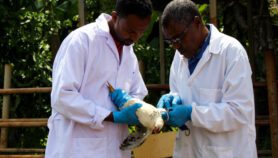By: Rafael Loyola
Send to a friend
The details you provide on this page will not be used to send unsolicited email, and will not be sold to a 3rd party. See privacy policy.
Scientists in developing countries should increase the quality of their research by publishing more good papers, not fewer, says Rafael Loyola.
Scientists in the developing world are under growing pressure to publish more every year. Some would argue that these quantitative metrics are promoting a scientific distortion, in which quantity prevails over quality — that is, publishing papers in journals with high impact factors.
In certain developing countries, the ability of researchers or institutions to obtain funding is closely related to their productivity, measured as the number of scientific papers they publish.
Since Brazil started applying this metric in the 2000s to evaluate researchers’ performance, its science has improved, with a greater number of papers published in high-impact-factor journals and new research networks established.
SPEED READ
- The ‘Slow Science’ movement calls for quality not quantity
- But Brazil’s focus on high productivity has improved its science and led to more funding
- Regularly writing up research leads to better papers
The global Slow Science movement seeks to move away from an emphasis on productivity.
It claims that pressure to publish leaves scientists with insufficient time to think about important issues that require in-depth discussion and reflection, such as poverty alleviation and the development of a cancer vaccine.
But while such a movement may be attractive to some, it should be applied with caution in countries where research capabilities are still developing.
I believe that slow science does not work for developing countries.
Slow spread
The Slow Science movement originated in Germany and its ideas are now spread by the Slow Science Academy. It has been popular in developed nations, such as the United States, that have a strong research capacity. The movement’s manifesto argues that focusing on productivity limits researchers’ creativity, preventing them from taking "time to think … time to read, and time to fail".
The need to publish more papers, say researchers, ultimately leads to shorter papers with superficial discussions, an increasing number of quantitative rather than descriptive reviews and the replacement of field-based papers with modelling papers. [1]
However, the increase in Brazil’s publishing output has brought enormous growth in science.
For example, investment in science education has increased, fostered by the establishment of new graduate training programmes and the implementation of policies to incentivise national and international cooperation.
Reducing publication output at this crucial stage of growth could be detrimental.
I have previously argued, together with colleagues from the Federal University of Goiás, Brazil, that focusing on productivity is a tough but necessary step on the way to establishing a more mature system in which the quality of science papers will eventually supersede quantity as a focus of research strategies. [2]
The situation is similar in other Latin American nations, such as Argentina, Colombia and Mexico. In these countries, pressure from funding agencies and institutions to publish more papers has increased their scientific ranking across Latin America. In China, economic growth and a pressure to publish has dramatically increased the quality of science and technology. [3]
Practice is crucial
Highly productive researchers publish in both high-profile and medium-impact journals, while less productive ones mostly publish in low-impact journals. This is a clear argument against slowing scientific production, based on the impact factor as a well-established — if disputable — international metric of a journal’s scientific quality.
This pattern emerges for several reasons. Firstly, getting papers published is about practice. Whatever we do, we get better at it the more we do it.
Secondly, getting published in a high-profile journal boosts your reputation. For example, you might be asked to act as associate editor of an important journal in your field. Such invitations largely come about through networking.
Based on my experiences and those of my colleagues, highly productive scientists are usually skilled at networking. They are also good at initiating international, collaborative research, whose outcomes are usually solid and well discussed — and thus more likely to be published in high-profile journals.
Finally, high-quality international collaborative research helps scientists to raise funds, and this will ultimately attract more students, postdocs and young scientists to work with them, leading to more high-quality papers.
Time trade-off
This big picture is, of course, simplified, and there are exceptions. I also recognise that there is a trade-off in raising productivity: the more you need to publish, the less time is available for laboratory experiments or expeditions.
However, I also believe that publishing more papers is a natural consequence of a healthy, collaborative research environment and can be achieved within a big research group, even in those with busy senior scientists.
Therefore, developing countries should be cautious about the Slow Science movement. The emphasis by funders and research institutions on productivity may be global, but the history of scientific development varies considerably between developed and developing countries.
It takes time for nations to reach a state of steady scientific production from one in which production is still developing. For developed countries, focusing on productivity may limit creativity. But for developing ones, having such a focus for now can help to improve national science.
In Brazil, the implementation of metrics and indicators of science and technology development have helped the country to better define its targets and encouraged local scientific communities to take a risk and aim for publication in high-profile journals.
If the history of scientific development were compared to a train going up and down a hill, it is sensible to slow its speed when it’s descending to safeguard against derailment. But applying the brakes when it is climbing will cause it to roll back to its starting point — leading it to arrive late at its destination.
Rafael Loyola is head of the Conservation Biogeography Lab and associate professor of ecology and evolution at the Federal University of Goiás, Brazil. He can be contacted at [email protected].
References
[1] Trends in Ecology & Evolution doi: 10.1016/j.tree.2012.05.010 (2012)
[2] Trends in Ecology & Evolution doi: 10.1016/j.tree.2012.07.016 (2012)
[3] Scientometrics doi: 10.1007/s111920–120–703-z (2012)













